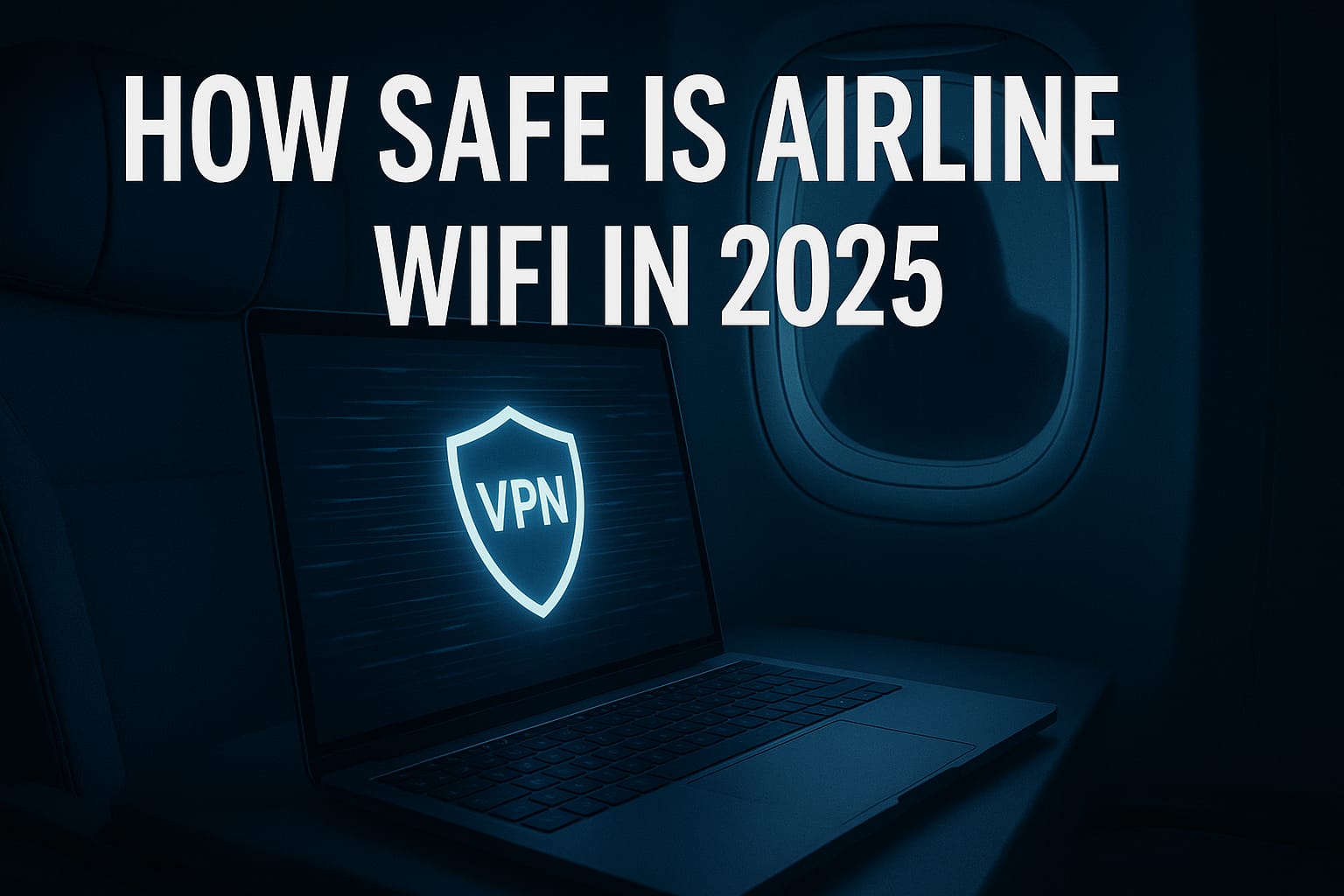How Safe Is Airline Wi‑Fi in 2025? Discover the real cyber risks on flights in 2025—what hackers do, how to spot them, and how to protect your personal data on every journey.
Is In-Flight Wi‑Fi Safe—or a High-Tech Trap?
You board the flight, settle in, and connect to “Airline Wi‑Fi” to get some work done, scroll social media, or stream your favourite show. It seems harmless—but even at 30,000 feet, hackers can strike.
In 2025, the aviation cyber landscape has evolved:
- Hackers are targeting passenger devices through airline Wi‑Fi
- Some rely on man-in-the-middle techniques
- Airlines are under pressure to fix vulnerabilities while maintaining connectivity
In this article, you’ll learn:
- How airline Wi‑Fi works (and why it’s vulnerable)
- Real-world cyber threats at 30,000 feet
- How to connect safely on USA, UK, and Canadian carriers
- 10 proven in-flight cybersecurity measures
- Expert tips to travel smarter and safer
Let’s dive in and turn your in-flight Wi‑Fi from a risk into an asset.
How Airline Wi‑Fi Actually Works (And Why It’s Risky)
Contrary to in-flight bragging, airline Wi‑Fi is not just a simple hotspot—it’s a complex satellite or ground network. Here’s why it matters:
- 🛰️ Satellite vs Ground Connection: Airlines use satellite links or ground stations to connect the plane to the internet. Data travels through multiple hops—each one a potential target.
- 👥 Shared Local Networks: All passengers connect through the same network. Without strong encryption, your traffic is visible to others.
- 🧑💻 Limited IT Oversight: Security patches aren’t always updated mid-flight. Threats evolve faster than onboard systems.
Key Vulnerability: Encryption Falls Short
- Many airlines still allow unencrypted connections or weak protocols due to compatibility issues.
- Even if HTTPS is used, hackers can exploit DNS or certificate vulnerabilities.
🎯 Real Cyber Threats on Flights in 2025
1. Man-in-the-Middle (MitM) on the Go
Hackers can launch MitM attacks to:
- Steal passwords and session cookies
- Replace downloaded files with malware
- Inject misleading websites or pop-ups
Even one victim can compromise the entire cabin’s session cookies.
2. Rogue Access Points within the Cabin
Fake Wi‑Fi names like “Flight_Wi‑Fi_PLANE123” can mimic airline hotspots.
Hackers lure you in before passengers can—it’s suspicious but increasingly common.
3. Spyware Distribution through Automatic Updates
If your device auto-updates apps while connected, hackers can push spyware disguised as updates—without your knowledge.
4. Eavesdropping via Local Network Scanning
Even if you’re just browsing, sensitive data might still leak:
- DNS leaks reveal your visited websites
- Bonjour or Windows File Sharing shows device names
- Open ports on your laptop can be scanned and exploited
5. Targeted Attacks for High-Value Individuals
Business travellers are particularly at risk:
- Hackers look for corporate credentials and intellectual property
- Nation-state groups have been documented intercepting secure emails via flight Wi‑Fi
Risk Levels for USA, UK, and Canada Flights
- 🇺🇸 US-Based Airlines: Strong federal regulations (FAA & TSA), but public attack surface remains high.
- 🇬🇧 UK Airlines: Oversight from CAA and ICO for data protection, though implementation is uneven.
- 🇨🇦 Canadian Airlines: Governed by CRTC and Transport Canada, yet mixed Wi‑Fi security levels.
Conclusion: The risk is global. Whether you’re flying Delta, British Airways, or Air Canada, you are a potential target.
10 Smart Security Steps to Take Onboard
1. Use a Trusted VPN
A virtual private network encrypts all traffic:
- Strong services: NordVPN, ExpressVPN, ProtonVPN, Surfshark
- Tip: Activate VPN before connecting to flight Wi‑Fi to ensure full protection
2. Avoid Sensitive Activities
📵Skip banking, shopping, or accessing work accounts via mobile email. These can be easily intercepted—even with HTTPS if DNS leaks occur.
3. Enable HTTPS Everywhere
Use this extension or browser mode for PC browsing to enforce HTTPS encryption at every connection.
4. Disable Auto‑Connect & File Sharing
Mac: System Settings → Network → Sharing → switch all off
Windows: Settings → Network → Advanced options → turn off sharing
Android/iPhone: Disable Bluetooth and Wi‑Fi auto-join, turn off local sharing
5. Use Privacy-Focused Browsers
Prefer browsers like Brave, DuckDuckGo, or Firefox Focus on mobile devices—they block trackers and fingerprinting by default.
6. Turn On Firewall & Antivirus
Ensure your device’s firewall is active:
- Windows Defender Firewall or macOS Firewall
- Install mobile antivirus with real-time protection like Bitdefender, Norton, or Kaspersky
7. Forget the Network After Use
Go to Wi‑Fi settings and hit “Forget This Network” the moment you disconnect to avoid auto-connecting on the return flight or at home.
8. Keep Operating System & Apps Updated
All major airlines provide landing ads and paywall interfaces—don’t ignore update reminders once on the ground.
9. Use Mobile Hotspot for Sensitive Tasks
If you have enough data, use your smartphone as a personal hotspot—it’s typically safer than airplane networks.
10. Use Two-Factor Authentication (2FA)
If a malicious actor intercepts login info:
- Requiring a code (even hardware token) prevents account takeover
Bonus Tips for Frequent Flyers
- Download essential movies or music before takeoff
- Prep emails offline using “draft” mode
- Disable sync features on your browser or apps
- Carry a portable battery charger for VPN-ready devices
🔗 Internal Links (For SEO & Audience Value)
- 🛡️ Top 5 VPNs for Privacy & Security in 2025
- 🌐 How to Protect Your Personal Data on Public Wi‑Fi (2025 Guide)
- 📱 Top 7 Signs Your Phone Is Hacked (2025)
Conclusion: Fly Safely, Connect Securely
In-flight Wi‑Fi can be a trap without proper precautions.
- Turn on your VPN
- Skip sensitive transactions
- Use privacy-focused browsers
- Disable auto-connect and sharing
And maybe keep that seatbelt on, emotionally—and digitally.
✈️ When you’re flying at 30,000 feet, your connection — not the cabin pressure — might be what really impacts your security.
